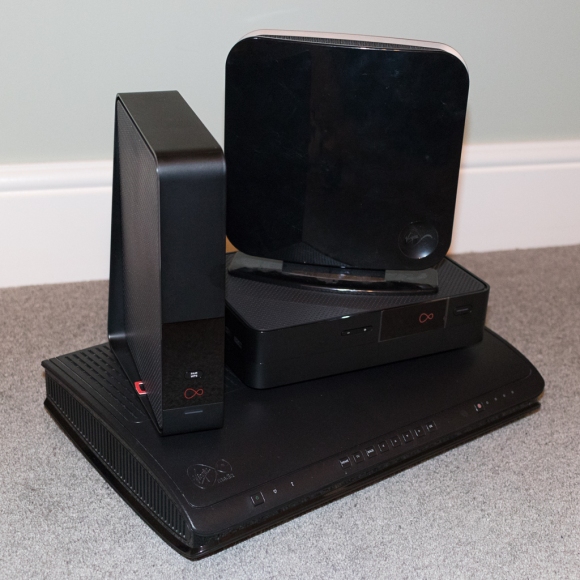
Modern devices such as TVs tend to be able to run in standby mode quite efficiently, which means the common advice about turning them off completely is becoming less relevant. However, retaining the overall aim of reducing your overall energy footprint, new always-on devices such as modems, routers, set top-boxes that have a recording facility, etc., are more relevant targets as they are still active even when you’re not using them directly.
At home we use Virgin Media for our broadband and TV, with a TiVo box for recording. Having just upgraded to the SuperHub 3 and V6 TV box, I was curious to see if the power consumption of these always-on devices had improved.
Results
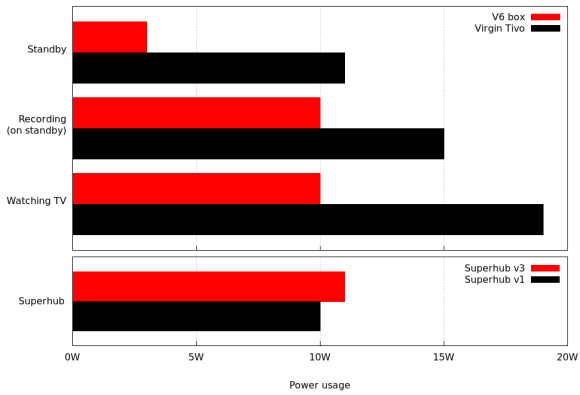
TV equipment
It looks good: the V6 box uses just over a third of the energy that the TiVo uses over a day of operation.
To get to the “one-third” estimate quoted above, I used a couple of observations and modelled the usage of the device over a typical day – your mileage may vary. As I will note below, the original Virgin TiVo seems to have two modes of standby and also seemed to be awake when it was not recording and in standby when I went to observe it on one occasion. I’m not sure exactly when this happens/what the cause is, nor am I sure the rules governing the higher-power standby, so I’ve tried to account for these by including 1 hour of time in the higher-power standby.
| Virgin TiVo | Virgin V6 | ||||
| Duration | Power | Energy/day | Power | Energy/day | |
| Standby 1 | 16h | 11W | 176Wh | 3W | 48Wh |
| Standby 2 | 1h | 13W | 13Wh | 3W | 3Wh |
| Recording | 4h | 15W | 60Wh | 10W | 40Wh |
| Watching | 3h | 19W | 57Wh | 10W | 30Wh |
| Total | 24h | 306Wh | 121Wh | ||
Superhub (v1 vs. v3)
This is less good. I use the Superhub in modem mode (i.e. no wifi or other features enabled since these are implemented elsewhere on my network), but we see a modest 1W increase in general power usage (10W for the SH1 vs. 11W for the SH3, consistently):
| SuperHub 1 | SuperHub 3 | |||
| Power | Energy/day | Power | Energy/day | |
| Modem mode | 10W | 240Wh | 11W | 264Wh |
The (quite unscientific) measurement method

I used a plug-in power meter to measure the power consumption. This power meter is a modern equivalent, though the one I had is this one that is no longer sold.
The meter has a function that totals energy use but the resolution of the reading is too low for this testing, so instead I set up a camera pointing at the meter and sampled the reading at the start of each minute. I then took the average (mode) for the period as the result.
This could obviously be done much more efficiently and accurately with a meter that supports a data-logging facility and has higher accuracy, but I didn’t have that at the time and this served my purpose.
An aside on video tools
I used a Raspberry Pi Zero W with a camera module (without the IR filter, just because that’s what I already had lying around) to record video of the power meter during the measurement period. I used the raspivid program to capture video. To keep file sizes down, I saved the video at 320×240 resolution using a command similar to the following:
pi@cam:~ $ raspivid -w 320 -h 240 -o 2_v6_recording_standby.h264 -t $((1000 * 60 * 45))
$((1000 * 60 * 45)) in this case computes to 45 minutes of time, since the -t option specifies how long to record for in milliseconds. This creates a raw h264 file, but it needs to wrapped in a container format in order for media players to understand it: you can use the MP4Box program to create this (part of the gpac package):
pi@cam:~ $ MP4Box -add 2_v6_recording_standby.h264 2_v6_recording_standby.mp4
I then used a processing script to extract the image at 1-minute intervals, similar to the following (run on a different machine that had a working ffmpeg command):
#!/bin/bash for i in `seq 0 $((2 * 60))` ; do ffmpeg -ss $(($i * 60)) -i v6_recording.mp4 -frames:v 1 $i.bmp done
Observations
Virgin Tivo box
Firstly: standby. There are multiple power-saving settings for this device: the box was set to ‘Sleep’ for these tests, which is supposedly the most aggressive power-saving mode (see the Virgin Media help page on the subject for more info).
Here is a graph showing the unit in standby with a recording finishing at minute 51 and the subsequent time spent idle:
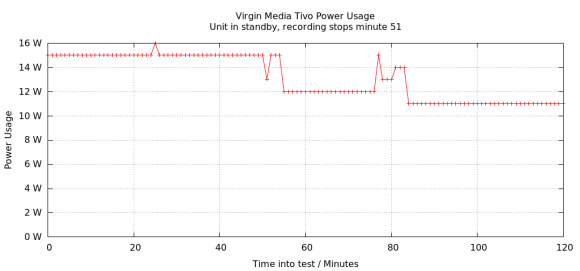
Note that for some time after the unit enters standby it sits at 12W, then later appears to power back up and then drops to 11W. I assume this is indicative that it enters a deeper sleep state when using 11W.
When I came to do further testing the next day, having left the power meter plugged in, I noticed it was showing 13W-15W for a while, then it reverted to 11W. It wasn’t turned on or recording at the time, so I assume it was doing some scheduled activity. As a result of this and the higher power draw when initially entering standby, I modelled a second standby state for the device above but it is a complete guess as to how much time is split between the states.
Watching TV consumes a relatively constant 19W:
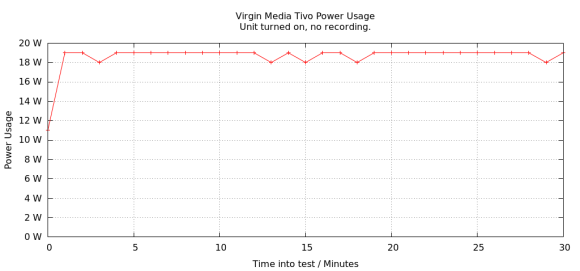
Virgin V6 box
The V6 box was relatively consistent in its power usage compared with the original Tivo. Again, it was set to the most aggressive power-saving mode, the Eco standby mode.
Here is the unit in standby and idle:
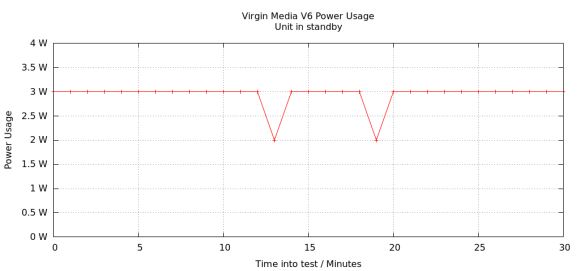
And watching TV – an almost-constant 10W:
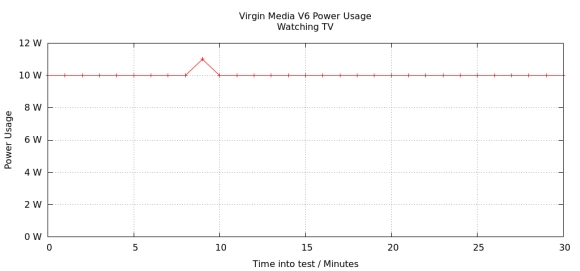
Finally, recording a program while the unit was in standby mode:

Conclusion
To put the 161Wh/day saving across both appliances into perspective, for me it accounts for a reduction of around 5% of my always-on energy consumption at home. I’d say it’s neither totally insignificant nor huge. However, I hope that by having information like this available to consumers it can enable people to take it into account when making purchasing decisions, and I couldn’t find anything to this level of detail already published for these two devices.
Tools like OpenEnergyMonitor or a smart meter can help you to understand your energy usage better, and with the help of these you could consider performing an audit to reduce unnecessary sources of consumption.

2 replies on “Power Usage of Virgin TiVo, V6 TV box, and SuperHub”
Nice review. I’m always keeping a close eye on energy consumption. In this modern day of ours, we can’t help but do that. Energy prices only go up!
Good to know there are significant savings to be made, when upgrading.
I would like to see an update for an extended time frame. Say a week or two.
LikeLike
Thank you for your review ,I normally have the Tivo box for about 8 hours a day and have just ordered the V6 today and I guess that the £2 extra subscription charge pm will be offset by the the similar saving in electricity plus it’s a better machine. Thanks again
LikeLike